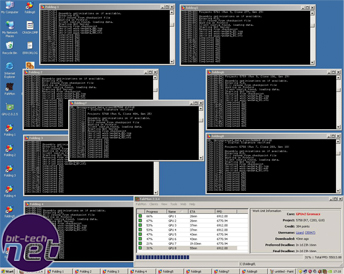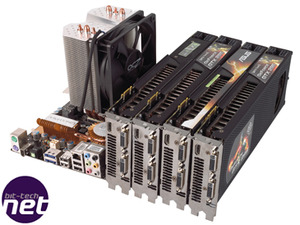PC 2: The eight-GPU challenge
After the failure of the P6T6 WS Revolution to fold on all six graphics cards, we decided that another approach was required. As our testing had already proved that the GeForce GTX 295 is the most powerful card for folding, as it can fold two WUs simultaneously, our next system was designed to run four GTX 295 cards in parallel. An ideal motherboard for this job is the aforementioned MSI K9A2 Platinum, as it can support four dual-slot PCI-E graphics cards, and uses cheap AMD Socket AM2+ processors and DDR2 memory.As the system would require a PSU with four 6-pin and four 8-pin PCI-E power connectors, and (by our rough calculations) be capable of drawing around 1kW, we stuck with the 1.05kW Enermax Revolution PSU. To keep down the overall cost of the system as much as possible, we opted for one of the new Kuma core Athlon X2 7750 Black Edition CPUs and 2GB of DDR2. As we eventually planned to install four GTX 295s in the system, we opted to use Windows XP rather than Vista, as it’s much easier to run multiple GPUs on the former OS. You’ll also need a right-angled S-ATA cable, since the third dual-slot graphics card prevents the use of standard straight S-ATA cables.
This kit was more than capable of powering a pair of GTX 295s; with all four GPUs folding, it produced a healthy 27,224ppd with a power draw of 528W. Adding a third GTX 295 increased the ppd to 41,331 and the power draw to 778W. However, the cards sit so close to each other on the motherboard that they became extremely hot, so we had to manually increase the fans’ speed to 75 per cent using RivaTuner to prevent them from dying.


Eight folding clients not only dominate the Windows desktop, but also do a great job of baking any room in which they're running.
Although we’d originally planned on trying to build this folding supercomputer inside a case, given the extremely high amount of heat generated by the eight GPUs, we knew that no case could keep the system cool enough to run stably. The layout of the motherboard also means that if all four PCI-E slots are populated with dual-slot graphics cards, you can’t reach the power button or jumper, so it’s impossible to switch on the PC if it’s installed inside a case. We increased the speed of the cards’ fans to 100 per cent using RivaTuner, and added two high-speed 120mm fans blowing over the cards. This made the system so loud that nobody wanted to sit next to it. The next stop, four GTX 295s, each folding two WUs in parallel, was disappointing at first. The ppd barely rose at all, merely edging up to 42,643, while the power draw increased to 895W. Although our first thought was that one of the cards had died due to the extreme temperatures at which they were running, all the clients were working correctly. However, FahMon indicated that the ppd of each GPU had dropped from the roughly 6,900ppd they were generating with three GTX 295s to 5,300ppd.
After some investigation, we noted that although the CPU wasn’t maxed out, the folding clients were all runnning on core 0 of the CPU, leaving core 1 idle. Thinking that this might be the cause of the low ppd when all eight GPUs were folding, we used Task Manager to manually set the affinity of the first four GPU folding clients to CPU core 0 and the last four GPU folding clients to CPU core 1. This small tweak fixed the problem, increasing the ppd of each GPU back to its expected 6,900 mark. However, as the clients picked up different work units the CPU utilisation did slowly creep up to the 100 per cent mark, lowering the ppd. As a result we decided to upgrade the CPU to a faster quad-core Phenom II X4 810, so that the GPUs would not be CPU limited.
With all eight GPU clients folding optimally, the ppd of the entire system rose to a terrific 55,013, although its power consumption rose to 983W. Even so, the ppd per pound of this system is more than double that of the seven-GPU system based on the Asus P6T7 WS Revolution. Clearly, although the initial outlay is greater, an MSI K9A2 Platinum and four GTX 295s is the ultimate folding machine.
PC 2 details
- Graphics cards: 4 x Nvidia GeForce GTX 295, £348.73 each
- Motherboard: MSI K9A2 Platinum, £105.79
- CPU: AMD Phenom II X4 810, £126.47
- RAM: 2GB of Corsair XMS2-8500, £33.18
- Hard disk: 250GB Hitachi HDT721025SLA380, £30.58
- PSU: 1.05kW Enermax Revolution, £195.04
- Operating system: Windows XP, £61.86
- Total cost: £1,947.84
- Total power draw: 983W
- Total points per day: 55,013ppd
Coda
Once you’ve chosen and installed all the hardware and software, don’t forget to drop into the folding forum to say hello.Custom PC & bit-tech would like to thank BFG for supplying much of the hardware used in this feature.

MSI MPG Velox 100R Chassis Review
October 14 2021 | 15:04









Want to comment? Please log in.